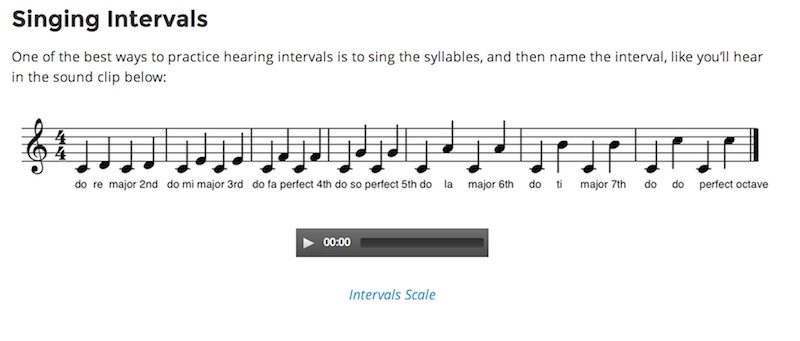Now that we’ve learned some of the basic principals of solfege syllables and how to determine the tonic, let’s discuss intervals. Recognizing the distinct sound of different intervals and being able to sing them back accurately in solfege will go a long way with developing transcribing skills.
What Are Intervals?
An interval is the space between two pitches. In Western music, we measure that space using half-steps. The half-step is the smallest interval on Western instruments like the guitar and piano, since the frets or keys are set to be half-steps apart from one another.
Some readers are probably familiar with whole-steps and half-steps. Here are the intervals in a major key:
- Major 2nd
- Major 3th
- Perfect 4th
- Perfect 5th
- Major 6th
- Major 7th
- Octave
Do you know how I determined the interval names?
I’m talking about every note in the scale as it relates to the tonic, also known as do. If you aren’t familiar with “major” “minor” and “perfect”, or how to construct and name intervals, check out this tutorial.
Intervals in the Context of the Major Scale
C is our tonic, so we know that:
- Do-Re (C-D) = Major 2nd
- Do-Mi (C-E) = Major 3rd
- Do-Fa (C-F) = Perfect 4th
- Do-So (C-G) = Perfect 5th
- Do-La (C-A) = Major 6th
- Do-Ti (C-B) = Major 7th
- Do-Do (C-C) = Perfect Octave
Singing Intervals
One of the best ways to practice hearing intervals is to sing the syllables, and then name the interval, like you’ll hear in the sound clip below:

Singing intervals is another way to strengthen the connection between what you’re hearing, and your brain’s interpretation of the pitches. If you spend 20 minutes per day singing and identifying intervals, it’s like practicing vocabulary words in a foreign language. Suddenly, intervals will pop out of melodies as something you recognize. Singing the name of the interval along with the solfege pitches creates additional neural pathways that will immediately recognize the interval in the context of a melody. You may feel silly at first, but it is a fast and effective way to get your ear working.
Hearing Intervals
The converse of singing intervals for practice is to listen and name them. A great tool for this practice is the Relative Pitch app, available in the App Store. By hearing intervals in isolation and naming them individually, you are building a vocabulary of recognized patterns that you can put together to identify melodies.
Try to name the interval from this sound clip:
Does it sound familiar?
The answer is do-re, major 2nd.
Here’s another:
First, listen for the starting note. If you didn’t recognize it, play the clip again.
Did you recognize that the starting pitch in example 2 was the same as in example 1?
Now listen and try to recognize the second note. If you still can’t tell what the second note is, think about a major scale. How many notes would you sing in the major scale (starting from the first note) to get to the second?
Replay the clip as much as you need to, and try to sing the notes in between the first pitch and the second pitch.
So, can you tell what the interval is? It’s a Major 3rd. The first pitch is do, and you can sing up the scale do-re-mi to realize the second note is mi, like this:
The next article will discuss singing and hearing scales, so if you aren’t able to sing or hear the scale in between these two pitches, don’t worry – read on!
Practice, Practice, Practice
Spend equal time on singing and hearing practice. You may find you excel at one more easily than the other, but they complement each other.
Interval ear training can help you with a variety of real musical tasks.
For example:
- Appreciate and understand harmonies
- Hear how melodies are constructed
- Play by ear, using your improved sense of pitch distances
- Sight-sing by using intervals to understand the sheet music
- Distinguish mistakes or inaccuracies in pitch and tuning
Explore more interval resources.
So far, we’ve covered the basics of solfege and talked about intervals. In the next article, we will discuss singing and hearing scales, and how expanding our musical vocabulary will enable us to hear even more complex melodies and harmonies.
As always, we want to hear from you! Leave questions or comments below.









